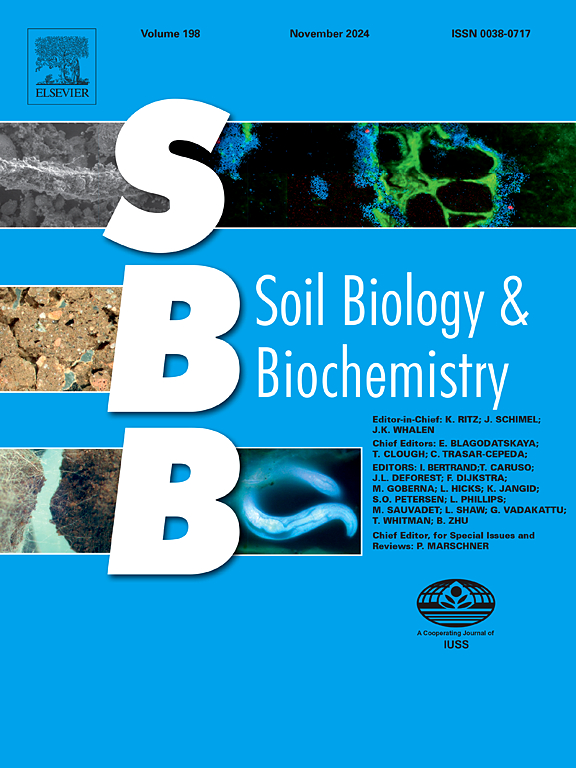Ver ítem
- xmlui.general.dspace_homeCentros Regionales y EEAsCentro Regional Patagonia NorteEEA BarilocheArtículos científicosxmlui.ArtifactBrowser.ItemViewer.trail
- Inicio
- Centros Regionales y EEAs
- Centro Regional Patagonia Norte
- EEA Bariloche
- Artículos científicos
- Ver ítem
Soil food-web energy fluxes reveal diverse responses to smallholder land-use choices in temperate forests
Resumen
The consequences of land-use change for soil fauna communities and soil functionality are hard to quantify and poorly understood. Energy fluxes provide a quantitative framework to link soil food webs to ecosystem functions. Here, we examined topsoil fauna in a forest-agriculture matrix in North Patagonia, Argentina, to assess the variation of soil food-web functioning across a gradient of land-use intensity. The sampled plots included reference forests,
[ver mas...]
The consequences of land-use change for soil fauna communities and soil functionality are hard to quantify and poorly understood. Energy fluxes provide a quantitative framework to link soil food webs to ecosystem functions. Here, we examined topsoil fauna in a forest-agriculture matrix in North Patagonia, Argentina, to assess the variation of soil food-web functioning across a gradient of land-use intensity. The sampled plots included reference forests, cattle grazing in forests, sheep grazing in meadows, perennial berry crops and seasonal vegetable crops. In each plot, we extracted soil fauna, measured their body sizes, estimated metabolic rates, and applied the soil food-web energy fluxes approach to assess associated trophic functions. Our findings revealed a greater total faunal biomass and energy flux in most land-use systems compared to native forests, while the number of interactions and the energetic inequality (unevenness in resource consumption) did not show a single pattern. Soil organic matter (SOM) consumption increased in sheep-grazed meadows and seasonal plots, while litter transformation decreased in the latter, and microbivory increased in most land-uses. The ratio between SOM consumption and faeces production, was greater in sheep-grazed meadows and seasonal plots, indicating a lower contribution to C sequestration by soil fauna. Herbivory and predation showed different patterns between seasons, but a reduced top-down herbivore control potential was found under sheep grazing. Overall, native and cattle-grazed forests showed lower energy fluxes but more balanced ecosystem functions. Perennial crops hosted more interactions and a similar potential for carbon storage and herbivore control as forests. In sheep-grazed meadows and seasonal crops, increased soil fauna biomass and energy flux were mainly reflected in higher SOM consumption. Our research shows how smallholder land-use choices result in different, often contrasting, effects on soil food-web structure and related functions, emphasizing the importance of human decisions for soil functional sustainability.
[Cerrar]

Autor
Pérez Roig, Camila;
Videla, Martin;
El Mujtar, Veronica Andrea;
Tittonell, Pablo Adrian;
Potapov, Anton M.;
Fuente
Soil Biology and Biochemistry 200 : 109619. (January 2025)
Fecha
2025-01
Editorial
Elsevier
ISSN
0038-0717
1879-3428
1879-3428
Documentos Relacionados
Formato
pdf
Tipo de documento
artículo
Proyectos
(ver más)
INTA/2019-PD-E2-I037-002, Biodiversidad edáfica: componente clave para una gestión integral y sustentable del recurso suelo
INTA/2019-PE-E1-I020-001, Desarrollo de criterios para diseño, monitoreo y evaluación de estrategias de intensificación sostenible de agroecosistemas, basadas en múltiples servicios ecosistémicos
INTA/2023-PD-L03-I103, Enfoques y metodologías para el estudio, monitoreo y diseño de agroecosistemas orientados a la intensificación ecológica
Palabras Claves
Derechos de acceso
Restringido
 Excepto donde se diga explicitamente, este item se publica bajo la siguiente descripción: Creative Commons Attribution-NonCommercial-ShareAlike 2.5 Unported (CC BY-NC-SA 2.5)
Excepto donde se diga explicitamente, este item se publica bajo la siguiente descripción: Creative Commons Attribution-NonCommercial-ShareAlike 2.5 Unported (CC BY-NC-SA 2.5)


